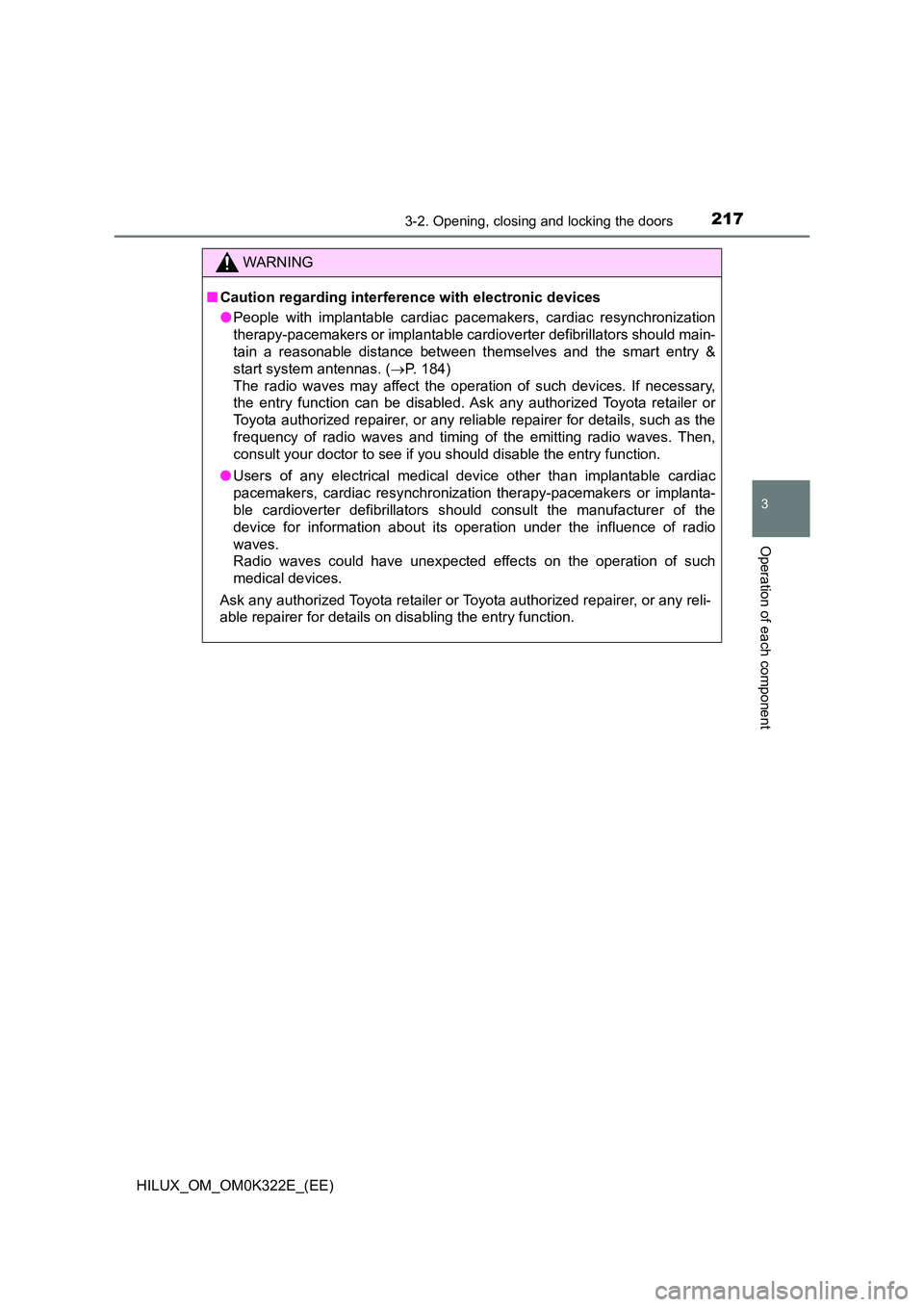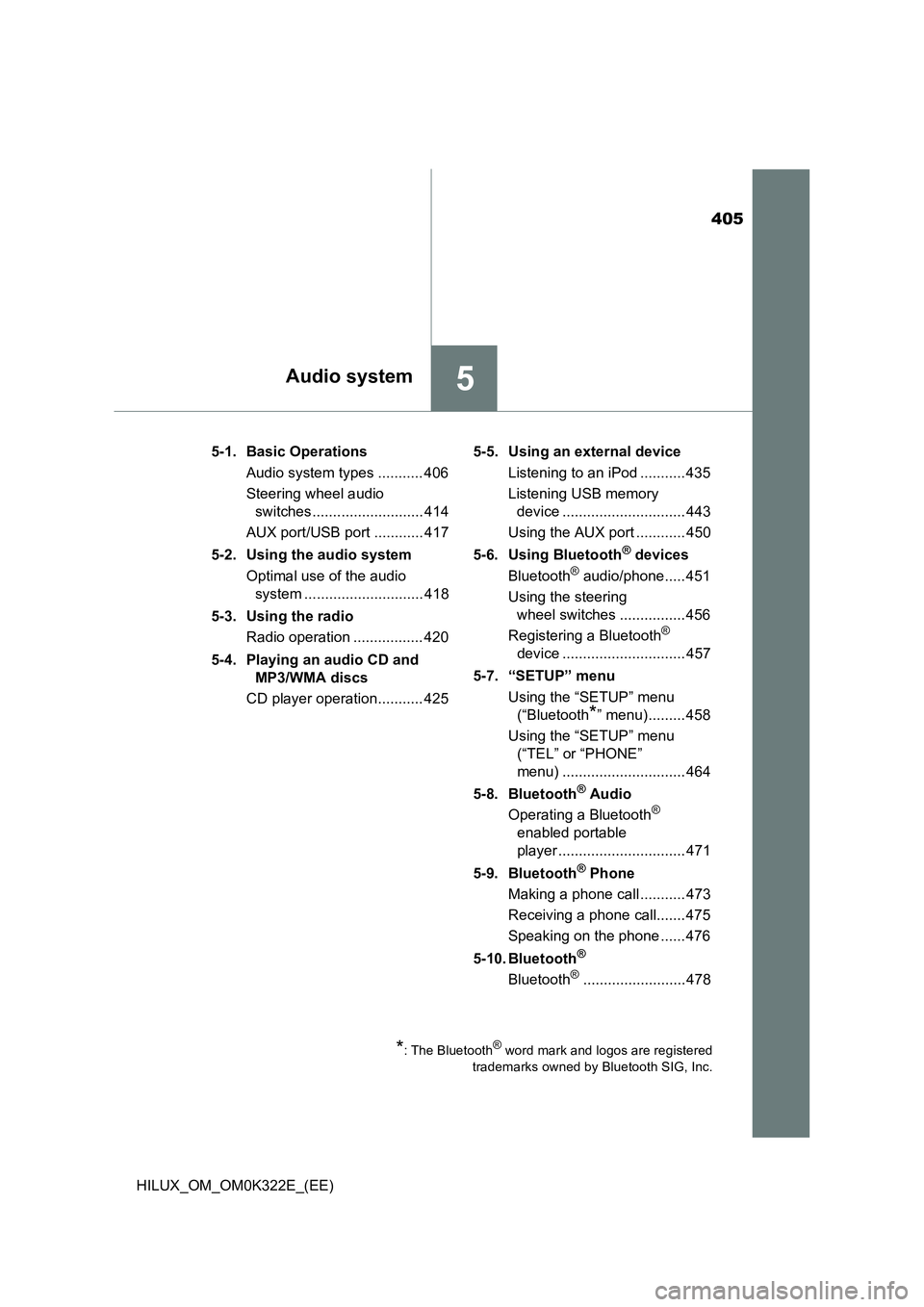Page 189 of 720

1893-2. Opening, closing and locking the doors
3
Operation of each component
HILUX_OM_OM0K322E_(EE)
■ If the smart entry & start system does not operate properly
● Locking and unlocking the doors: Use the mechanical key. (P. 644)
● Starting the engine: P. 645
■ Electronic key battery depletion
● The standard battery life is 1 to 2 years.
● If the battery becomes low, an alarm will sound in the cabin when the engine
stops.
● As the electronic key always receives radio waves, the battery will become
depleted even if the electronic key is not used. The following symptoms indi-
cate that the electronic key battery may be depleted. Replace the battery
when necessary. ( P. 575)
• The smart entry & start system or the wireless remote control does not
operate.
• The detection area becomes smaller.
• The LED indicator on the key surface does not turn on.
● To avoid serious deterioration, do not leave the electronic key within 1 m (3
ft.) of the following electrical appliances that produce a magnetic field:
•TVs
• Personal computers
• Cellular phones, cordless phones and battery chargers
• Recharging cellular phones or cordless phones
• Table lamps
• Induction cookers
■ If “KEY LEFT INSIDE VEHICLE”/“Key left inside vehicle” is shown on the
multi-information display (if equipped)
An attempt was made to lock the doors using the smart entry & start system
while the electronic key was still inside the vehicle, or an attempt was made
to lock either front door by opening a door and putting the inside lock button
into the lock position, then closing the door by pulling on the outside door
handle with the electronic key still inside the vehicle.
Retrieve the electronic key from the vehicle and lock the doors again.
■ Customization that can be configured at any authorized Toyota retailer
or Toyota authorized repairer, or any reliable repairer
Settings (e.g. smart entry & start system) can be changed.
(Customizable features: P. 695)
■ If the smart entry & start system has been deactivated in a customized
setting
● Locking and unlocking the doors:
Use the wireless remote control or mechanical key. ( P. 174, 644)
● Starting the engine and changing engine switch modes: P. 645
● Stopping the engine: P. 271
Page 217 of 720

2173-2. Opening, closing and locking the doors
3
Operation of each component
HILUX_OM_OM0K322E_(EE)
WARNING
■Caution regarding interference with electronic devices
● People with implantable cardiac pacemakers, cardiac resynchronization
therapy-pacemakers or implantable card ioverter defibrillators should main-
tain a reasonable distance between themselves and the smart entry &
start system antennas. ( P. 184)
The radio waves may affect the operation of such devices. If necessary,
the entry function can be disabled. Ask any authorized Toyota retailer or
Toyota authorized repairer, or any reliable repairer for details, such as the
frequency of radio waves and timing of the emitting radio waves. Then,
consult your doctor to see if you should disable the entry function.
● Users of any electrical medical device other than implantable cardiac
pacemakers, cardiac resynchronizati on therapy-pacemakers or implanta-
ble cardioverter defibrillators should consult the manufacturer of the
device for information about its operation under the influence of radio
waves.
Radio waves could have unexpected effects on the operation of such
medical devices.
Ask any authorized Toyota retailer or To yota authorized repairer, or any reli-
able repairer for details on disabling the entry function.
Page 329 of 720
3294-5. Using the driving support systems
4
Driving
HILUX_OM_OM0K322E_(EE)
• When rapidly closing on an electric toll gate barrier, parking area barrier,
or other barrier that opens and closes
• When using an automatic car wash
• When the vehicle is hit by water, snow, dust, etc. from a vehicle ahead
• When driving through steam or smoke
• When there are patterns or paint on the road or a wall that may be mis-
taken for a vehicle or pedestrian
• When driving near an object that reflects radio waves, such as a large
truck or guardrail
• When driving near a TV tower, broadcasting station, electric power plant,
or other location where strong radio waves or electrical noise may be
present
• When passing under an object (bill-
board, etc.) at the top of an uphill road
• When driving through or under
objects that may contact the vehicle,
such as thick grass, tree branches, or
a banner
Page 405 of 720

405
5Audio system
HILUX_OM_OM0K322E_(EE)
5-1. Basic Operations
Audio system types ........... 406
Steering wheel audio
switches ........................... 414
AUX port/USB port ............ 417
5-2. Using the audio system
Optimal use of the audio
system ............................. 418
5-3. Using the radio
Radio operation ................. 420
5-4. Playing an audio CD and
MP3/WMA discs
CD player operation........... 425
5-5. Using an external device
Listening to an iPod ........... 435
Listening USB memory
device .............................. 443
Using the AUX port ............ 450
5-6. Using Bluetooth® devices
Bluetooth® audio/phone..... 451
Using the steering
wheel switches ................ 456
Registering a Bluetooth®
device .............................. 457
5-7. “SETUP” menu
Using the “SETUP” menu
(“Bluetooth*” menu)......... 458
Using the “SETUP” menu
(“TEL” or “PHONE”
menu) .............................. 464
5-8. Bluetooth® Audio
Operating a Bluetooth®
enabled portable
player ............................... 471
5-9. Bluetooth® Phone
Making a phone call ........... 473
Receiving a phone call....... 475
Speaking on the phone ...... 476
5-10. Bluetooth®
Bluetooth®......................... 478
*: The Bluetooth® word mark and logos are registered
trademarks owned by Bluetooth SIG, Inc.
Page 406 of 720
4065-1. Basic Operations
HILUX_OM_OM0K322E_(EE)
Audio system types
Vehicles with multimedia system
Refer to the “Navigation and multimedia system Owner’s manual”.
Vehicles without multimedia system
CD player with AM/FM radio
● Ty pe A
● Ty pe B
This illustration is for a left-hand drive vehicle. Some button positions
are reversed for right-hand drive vehicles. (type B only)
: If equipped
Page 414 of 720
4145-1. Basic Operations
HILUX_OM_OM0K322E_(EE)
Steering wheel audio switches
Vo lu m e
Radio mode:
Selects a radio station
CD mode:
Selects a track and file (MP3
and WMA)
Bluetooth® audio mode:
Selects a track
iPod mode:
Selects a song
USB memory mode:
Selects a file
Power on, select audio source
: If equipped
Some audio features can be controlled using the switches on
the steering wheel.
Operation may differ depending on the type of audio system or
navigation system. For details, refer to the manual provided with
the audio system or navigation system.
1
2
3
Page 415 of 720
4155-1. Basic Operations
5
Audio system
HILUX_OM_OM0K322E_(EE)
Press the “MODE” switch when the audio system is turned off.
Press the “MODE” switch when the audio system is turned on. The
audio source changes as follows each time the button is pressed. If a
mode cannot be used, it will be skipped.
AM FM1FM2*CD modeiPod or USB memory
Bluetooth® audio* AUX
*: If equipped
Press the “+” switch to increase the volume and the “-” switch to
decrease the volume.
Hold down the switch to continue increasing or decreasing the volume.
Press and hold the “MODE” switch.
To cancel, press and hold the switch again.
Press the “MODE” switch to select the radio mode.
Press the “ ” or “” switch to select a preset station.
To scan for receivable stations, press and hold the switch until you hear a
beep.
Turning on the power
Changing the audio source
Adjusting the volume
Silencing a sound
Selecting a radio station
1
2
Page 420 of 720
4205-3. Using the radio
HILUX_OM_OM0K322E_(EE)
Radio operation
Ty pe A
Press the “MODE” button until “AM” or “FM” is displayed.